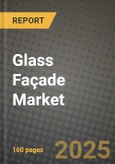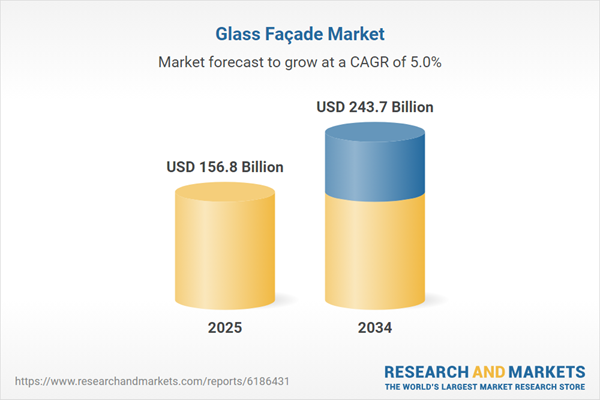The glass façade market has emerged as a transformative force in modern architecture, revolutionizing the visual appeal and energy performance of commercial and residential buildings alike. Glass façades, known for their transparency, sleekness, and ability to maximize natural light, are now synonymous with contemporary urban landscapes. From skyscrapers to institutional structures, the use of glass façades enhances both aesthetics and functionality, offering improved insulation, noise reduction, and solar control. The market is being propelled by rapid urbanization, rising construction activity, and a growing emphasis on sustainable building solutions. Governments and regulatory bodies are increasingly promoting energy-efficient infrastructure, which has led to higher demand for double and triple-glazed façades with low-emissivity coatings. The trend is further accelerated by the shift towards smart cities and green buildings, where glass façades play a crucial role in achieving energy goals without compromising design. As architectural styles continue to evolve, the market is expected to remain on an upward growth curve driven by both innovation and environmental priorities.
The glass façade market experienced a series of key developments centered around sustainability, digital integration, and design flexibility. Leading manufacturers introduced advanced façade systems embedded with smart sensors for automatic light and heat regulation, responding to the growing demand for intelligent building solutions. New materials such as electrochromic and photovoltaic glass gained momentum, allowing buildings to generate energy while maintaining optimal indoor comfort. Additionally, governments in regions like Europe and Asia implemented stricter green building codes, mandating higher efficiency standards for building envelopes, which significantly benefited the façade segment. On the architectural front, the use of curved and frameless glass became increasingly popular, showcasing the technological capabilities of modern fabrication methods. Builders and developers across major cities emphasized curtain wall systems and modular façades for faster, cost-effective construction. Collaborations between glass manufacturers and construction technology firms were also notable, focusing on BIM (Building Information Modeling) for façade design optimization and lifecycle management. These developments reflect a market in transition, embracing both aesthetics and performance in equal measure.
The glass façade market is poised for accelerated innovation and broader adoption driven by climate goals, urban design reforms, and advancements in manufacturing. The integration of AI and IoT technologies will enable façades to become dynamic systems capable of real-time environmental adaptation. Governments are expected to introduce incentive programs supporting net-zero construction, further pushing the adoption of high-performance façade systems. Innovations like vacuum-insulated glass and transparent solar panels are anticipated to enter the mainstream, offering superior energy efficiency without compromising design. Additionally, emerging economies in Asia-Pacific, Latin America, and the Middle East will present lucrative opportunities as they invest heavily in smart infrastructure and green urban planning. The architectural trend toward biomimetic and kinetic façades - designed to interact with environmental conditions - will redefine future skylines. Moreover, growing concerns around urban heat islands and indoor wellness will prompt demand for glass that not only looks appealing but actively contributes to healthier living spaces. The next phase of growth will be shaped by a blend of digital integration, environmental policy, and creative design thinking.
Key Insights: Glass Façade Market
- Electrochromic glass façades that dynamically adjust transparency levels based on sunlight intensity are gaining traction in office and commercial buildings, enabling improved thermal comfort and reduced energy consumption.
- Integration of photovoltaic glass in façade design is emerging as a viable method for on-site renewable energy generation, aligning with global net-zero emission targets.
- Architectural trends in 2024 favored frameless and curved glass façades, enhancing the aesthetic fluidity of urban structures and reflecting advancements in precision engineering and fabrication.
- Smart façade systems incorporating IoT sensors are being used to monitor heat gain, glare, and air quality, offering actionable insights for building performance optimization in real time.
- Use of Building Information Modeling (BIM) in façade planning is expanding, improving design accuracy, material efficiency, and project execution timelines across new developments.
- Urban expansion and high-rise construction projects in major cities are driving demand for glass façades due to their ability to enhance space, lighting, and energy performance.
- Regulatory mandates and green certification requirements such as LEED and BREEAM are pushing builders to adopt energy-efficient glass façades in compliance with sustainable design norms.
- Technological advances in glass treatment, lamination, and coating have significantly expanded the functional benefits of façades, making them more adaptable and durable in extreme environments.
- Consumer and tenant preferences for daylight-filled, modern interiors are influencing real estate developers to invest in transparent and visually striking building exteriors.
- High initial costs of advanced glass façade systems, including smart and solar-integrated variants, pose a barrier to adoption, especially for small-scale developers and projects in cost-sensitive regions.
Glass Façade Market Segmentation
By Product
- Tempered
- Insulated
- Laminated
- Other Products
By Shape
- Flat Tempered Glass
- Bent Tempered Glass
By Application
- Residential
- Non-Residential
Key Companies Analysed
- Koninklijke Ten Cate BV
- GSE Holdings Inc.
- NAUE GmbH & Co. KG
- Fibertex Nonwovens A/S
- HUESKER Synthetic GmbH
- Tensar International Corporation
- AGRU America Inc.
- Low & Bonar PLC
- Groupe Solmax Inc.
- Officine Maccaferri SpA
- Asahi Kasei Advance Corporation
- Belton Industries Inc.
- Propex Operating Company LLC
- Global Synthetics Pty Ltd.
- TYPAR
- Tenax Pidilite India Private Limited
- Solmax International Inc.
- CETCO Minerals Technologies Inc.
- Carthage Mills
- Geofabrics Australasia
- Geosynthetics Limited
- Hanes Geo Components
- Kaytech Engineered Fabrics
- Maccaferri Canada Ltd.
- Mattex Geosynthetics
- Nilex Inc.
- Owens-Corning Fiberglass Company
- Polymer Group Inc.
- Presto Geosystems
- Raven Industries
- Strata Systems
- TenCate Geosynthetics Americas
- Thrace Group
- Titan Environmental Containment
- Tuflex India Pvt. Ltd.
- Wrekin Products Ltd.
Glass Façade Market Analytics
The report employs rigorous tools, including Porter’s Five Forces, value chain mapping, and scenario-based modeling, to assess supply-demand dynamics. Cross-sector influences from parent, derived, and substitute markets are evaluated to identify risks and opportunities. Trade and pricing analytics provide an up-to-date view of international flows, including leading exporters, importers, and regional price trends.Macroeconomic indicators, policy frameworks such as carbon pricing and energy security strategies, and evolving consumer behavior are considered in forecasting scenarios. Recent deal flows, partnerships, and technology innovations are incorporated to assess their impact on future market performance.
Glass Façade Market Competitive Intelligence
The competitive landscape is mapped through proprietary frameworks, profiling leading companies with details on business models, product portfolios, financial performance, and strategic initiatives. Key developments such as mergers & acquisitions, technology collaborations, investment inflows, and regional expansions are analyzed for their competitive impact. The report also identifies emerging players and innovative startups contributing to market disruption.Regional insights highlight the most promising investment destinations, regulatory landscapes, and evolving partnerships across energy and industrial corridors.
Countries Covered
- North America - Glass Façade market data and outlook to 2034
- United States
- Canada
- Mexico
- Europe - Glass Façade market data and outlook to 2034
- Germany
- United Kingdom
- France
- Italy
- Spain
- BeNeLux
- Russia
- Sweden
- Asia-Pacific - Glass Façade market data and outlook to 2034
- China
- Japan
- India
- South Korea
- Australia
- Indonesia
- Malaysia
- Vietnam
- Middle East and Africa - Glass Façade market data and outlook to 2034
- Saudi Arabia
- South Africa
- Iran
- UAE
- Egypt
- South and Central America - Glass Façade market data and outlook to 2034
- Brazil
- Argentina
- Chile
- Peru
Research Methodology
This study combines primary inputs from industry experts across the Glass Façade value chain with secondary data from associations, government publications, trade databases, and company disclosures. Proprietary modeling techniques, including data triangulation, statistical correlation, and scenario planning, are applied to deliver reliable market sizing and forecasting.Key Questions Addressed
- What is the current and forecast market size of the Glass Façade industry at global, regional, and country levels?
- Which types, applications, and technologies present the highest growth potential?
- How are supply chains adapting to geopolitical and economic shocks?
- What role do policy frameworks, trade flows, and sustainability targets play in shaping demand?
- Who are the leading players, and how are their strategies evolving in the face of global uncertainty?
- Which regional “hotspots” and customer segments will outpace the market, and what go-to-market and partnership models best support entry and expansion?
- Where are the most investable opportunities - across technology roadmaps, sustainability-linked innovation, and M&A - and what is the best segment to invest over the next 3-5 years?
Your Key Takeaways from the Glass Façade Market Report
- Global Glass Façade market size and growth projections (CAGR), 2024-2034
- Impact of Russia-Ukraine, Israel-Palestine, and Hamas conflicts on Glass Façade trade, costs, and supply chains
- Glass Façade market size, share, and outlook across 5 regions and 27 countries, 2023-2034
- Glass Façade market size, CAGR, and market share of key products, applications, and end-user verticals, 2023-2034
- Short- and long-term Glass Façade market trends, drivers, restraints, and opportunities
- Porter’s Five Forces analysis, technological developments, and Glass Façade supply chain analysis
- Glass Façade trade analysis, Glass Façade market price analysis, and Glass Façade supply/demand dynamics
- Profiles of 5 leading companies - overview, key strategies, financials, and products
- Latest Glass Façade market news and developments
Additional Support
With the purchase of this report, you will receive:- An updated PDF report and an MS Excel data workbook containing all market tables and figures for easy analysis.
- 7-day post-sale analyst support for clarifications and in-scope supplementary data, ensuring the deliverable aligns precisely with your requirements.
- Complimentary report update to incorporate the latest available data and the impact of recent market developments.
This product will be delivered within 1-3 business days.
Table of Contents
Companies Mentioned
- Koninklijke Ten Cate BV
- GSE Holdings Inc.
- NAUE GmbH & Co. KG
- Fibertex Nonwovens A/S
- HUESKER Synthetic GmbH
- Tensar International Corporation
- AGRU America Inc.
- Low & Bonar PLC
- Groupe Solmax Inc.
- Officine Maccaferri SpA
- Asahi Kasei Advance Corporation
- Belton Industries Inc.
- Propex Operating Company LLC
- Global Synthetics Pty Ltd.
- TYPAR
- Tenax Pidilite India Private Limited
- Solmax International Inc.
- CETCO Minerals Technologies Inc.
- Carthage Mills
- Geofabrics Australasia
- Geosynthetics Limited
- Hanes Geo Components
- Kaytech Engineered Fabrics
- Maccaferri Canada Ltd.
- Mattex Geosynthetics
- Nilex Inc.
- Owens-Corning Fiberglass Company
- Polymer Group Inc.
- Presto Geosystems
- Raven Industries
- Strata Systems
- TenCate Geosynthetics Americas
- Thrace Group
- Titan Environmental Containment
- Tuflex India Pvt. Ltd.
- Wrekin Products Ltd.
Table Information
| Report Attribute | Details |
|---|---|
| No. of Pages | 160 |
| Published | October 2025 |
| Forecast Period | 2025 - 2034 |
| Estimated Market Value ( USD | $ 156.8 Billion |
| Forecasted Market Value ( USD | $ 243.7 Billion |
| Compound Annual Growth Rate | 5.0% |
| Regions Covered | Global |
| No. of Companies Mentioned | 36 |









